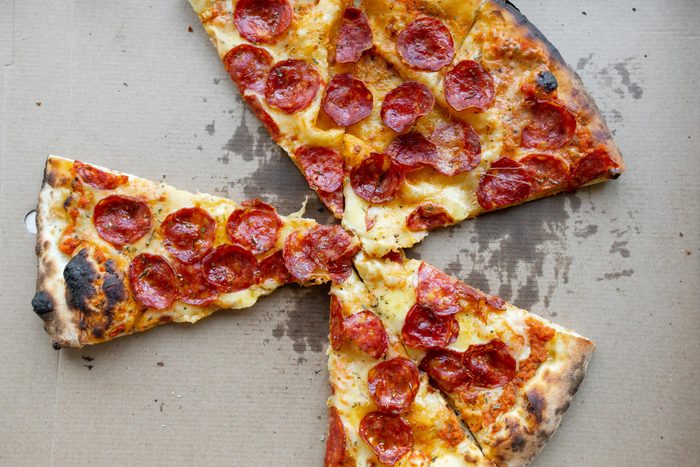Here’s How Much Sodium Is in a Slice of Pizza
Updated: Dec. 19, 2023

Pizza is the number-one favorite food in America—but with 20% of all deaths occurring from heart disease, one pervasive pizza ingredient might call you to contemplate how often you crack open that steaming cardboard box.
When you’re craving a hot, melty, delicious indulgence you can unwind with, chances are pretty good pizza comes to mind—after all, a 2020 survey found that 55% of American adults list pizza as their favorite comfort food. A fact that’s less comforting: Pizza isn’t exactly known for being healthy. It’s often high in fat, sugar, refined carbs…and especially, salt.
That last ingredient should concern anyone who’s watching salt intake (which should be all of us). If the fat, carbs, and calories aren’t enough to make pizza a strictly occasional treat, here’s how much sodium is in a slice—says Jessica Plowman, RDN, a sports nutritionist in Colorado: “Pizza is definitely considered a high-sodium food due to its combination of processed meats, cheeses, and salty sauces.” (Pssst…there’s usually even salt in pizza crust.)
How much salt do you need?
Sodium is an electrolyte that’s essential to how your body functions, so the goal isn’t to eliminate salt entirely from your diet. However, you probably need less than you think.
Adults only need about 2,300 milligrams of sodium, equating to one teaspoon of salt per day, according to the current US Dietary Guidelines for Americans. Plowman suggests you want to be mindful of that guideline, as too much dietary salt is a leading factor in high blood pressure and also contributes to heart disease, she says. Centers for Disease Control & Prevention (CDC) data in 2023 says that in the United States, heart disease remains the leading cause of death for men, women, and most individuals in racial and ethnic groups.
7 Clear Signs You’re Eating Too Much Salt
How much sodium is in pizza?
The amount of sodium in a slice of pizza can vary widely depending on the size of the slice, the type of crust, the toppings, and the specific recipe used.
However, on average, you can expect a typical slice of plain cheese pizza from a chain restaurant or a frozen pizza to contain between 600 to 1200 milligrams of sodium. That number, of course, can go much higher if the pizza has additional toppings like salty meats—pepperoni, ham, and sausage are known to be very high in sodium—or extra cheese, Plowman says.
Plus, perhaps the biggest factor to consider when it comes to pizza is the portion. Be honest: How often do we eat just one single slice of pizza? A meal is usually at least two slices (and sometimes three or more—they go down easy)!
That’s a problem, Plowman says: Eating two or three slices of pizza can easily take you over your recommended sodium allowance for the entire day.
I Ate Pizza Every Day for a Week—Here’s What Happened
How to reduce sodium in pizza
Plowman says it’s fine to indulge in pizza sometimes—just be smart about your choices. If you’re concerned about your sodium consumption, it’s a good idea to study the label…or if you’re ordering from a chain, check out their nutrition information online. Different brands of pizza and regional variations can lead to varying levels of sodium. You might be able to find low-sodium frozen pizzas in the freezer aisle.
Another wise way to slice it is to make your own pizza at home. Opt for low-sodium pizza sauce, low-sodium mozzarella cheese, and avoid high-salt toppings like olives and processed meats. Check out our list of the best cauliflower pizza crusts, all recommended by nutritionists.
Get The Healthy @Reader’s Digest newsletter and follow The Healthy on Facebook and Instagram. Keep reading:

















